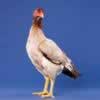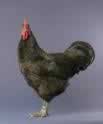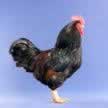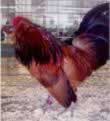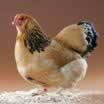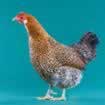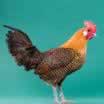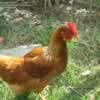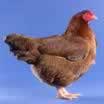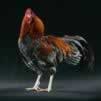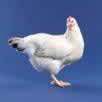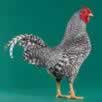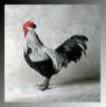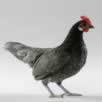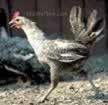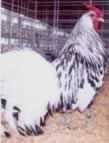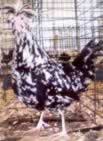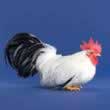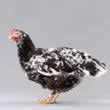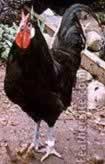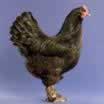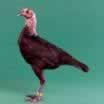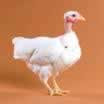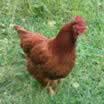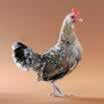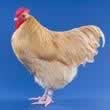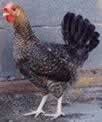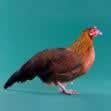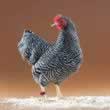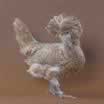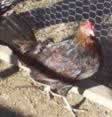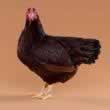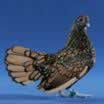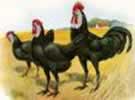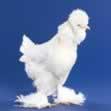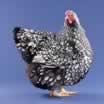Ameraucana (Easter Egger)
Eggs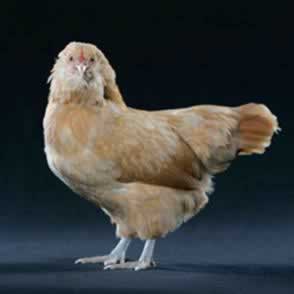
Size: Medium
Color: Blue and Green
Qty: High – 4 / wk
Temperment
Well adaptable to confinement or free range
Mostly calm, Non-aggressive
Brooding: good brooder
Hardiness: Very cold hardy
Maturing: Moderately early maturing
Physical
Varieties: Black, Blue, Blue-wheaten, Brown-red, Buff, Silver, Wheaten, & White
Weight: 5.5 lb (2.5 kg)
Comb: pea
Legs: white with slate colored shanks
Ears: red
Class
APA (1984)
- Large: All Other
- Bantam: All Other Clean Legged
PC: Not recognized
Type
Layer
Fancy: Muffed, Bearded
Rarity
Easter Eggers are common. Standard Ameraucanas are rare. 88%/8% (EEs/pure)
Origins
South American. May or may not be genetically related to the Araucana. In pre-Columbian Chile, there are several different blue egg-laying chicken breeds, none called Araucana. Standardized & accepted into APA in 1984. Most hatcheries, however, sell Easter Egg chickens with mixed breeding that may lay blue, green (or other colored) eggs, but do not conform to standard.
Notes
The chipmunky blue-egger.
| 2008 | Started with 3, but they were killed by the dog at about 8 wks old. Very nice temperment. The 4 wk older chickens picked on them. |
Links
Club: http://www.ameraucana.org
FeatherSite: http://www.feathersite.com/Poultry/CGA/Arau/BRKAmer.html
PoultryBreeds: http://www.afn.org/~poultry/breeds/ameraucn.htm
<top>
Blue Andalusian
Eggs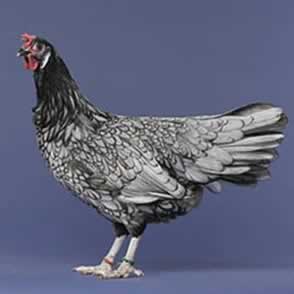
Size: Large
Color: chalk to creamy white
Qty: Medium – 3 / wk
Temperment
Economical eater; adaptable to confinement, but prefers free range
Active, flighty, noisy, avoids human contact
Brooding: mostly a non-setter
Hardiness: Hardy; heat tolerant; combs subject to frostbite
Maturing: Early maturing
Physical
Varieties: Blue
Weight:
- Standard: 5.5 lb (2.4 kg)
- Bantam: 1.75 lb (0.8 kg)
Comb: single
Legs: white skin, slate blue shanks
Ears: white
Class
APA (1874)
- Large: Mediterranean
- Bantam: Single Comb Clean Legged
PC: Light, Rare
Type
Layer
Fancy: Blue Feathered
Rarity
Still popular as a show bird. 32%
Origins
Developed in Spain & England in mid-19th century. Studied by Gregor Mendel in experiments in genetics & heredity.
Blue color does not breed true. Black & Splash (White) are necessary for breeding, but are not permitted to be shown.
Notes
(none)
| 2008 | “Special” – Kristen’s favorite chicken. Held just about every day until about 6 months old! |
Links
Okla State: http://www.ansi.okstate.edu/poultry/chickens/andalusian
PoultryBreeds: http://www.afn.org/~poultry/breeds/andalusn.htm
PoultryPages: http://www.poultrypages.com/andalusian.html
ChickenBox: http://www.kippengrabbelton.be/engels/
<top>
Faverolle (Salmon)
Eggs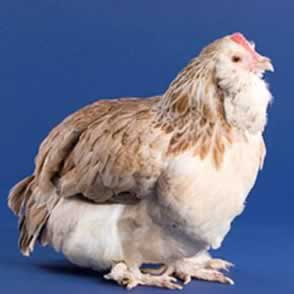
Size: Medium
Color: Creamy tint
Qty: High – 4 / wk
Temperment
Bears confinement well
Alert; calm; very docile; genteel
Prone to bullying by others
Brooding: can be broody
Hardiness: robust; cold hardy; because of fancy feathering,
not suited for foul weather
Maturing: early maturing
Physical
Varieties: Salmon, White
Weight:
- Standard: 7.5 lb (3.4 kg)
- Bantam: 2.2 lb (1.0 kg)
Comb: small single
Legs: white skin & shanks
Ears: red (hidden by feathers)
Class
APA (1914)
- Large: Continental
- Bantam: Feather Legged
PC: Soft Feathery Heavy
Type
Dual Purpose
Fancy: Bearded & muffed; Feather footed, outside only; Five-Toed
Rarity
Once rare, but gaining popularity. 44%
Origins
Developed in France in early 19th century.
Notes
The French Poodle of chicken breeds.
| 2008 | 1 died at 2 days old – pasting up. |
Links
Club: http://faverollesfanciers.org/
FeatherSite: http://www.feathersite.com/Poultry/CGD/Favs/BRKFaverolles.html
Okla State: http://www.ansi.okstate.edu/poultry/chickens/faverolles
Omlet UK: http://www.omlet.co.uk/images/faverolles_salmon_f_600.gif
PoultryPages: http://www.poultrypages.com/faverolle.html
ChickenBox: http://www.kippengrabbelton.be/engels/
<top>
Jersey Giant (Black)
Eggs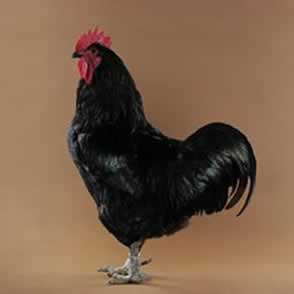
Size: Medium to large
Color: Brown
Qty: Medium – 3 / wk
Temperment
Not an economical eater
Adaptable to confinement or free range
Calm, gentle, easily handled
Brooding: good brooder, protective mother
Hardiness: robust; very cold hardy
Maturing: very slow to mature
Physical
Varieties: Black, White
Weight: 10 lb (4.6 kg)
Comb: small single
Legs: yellow skin, dark shanks
Ears: red
Class
APA (1922)
- Large: American
- Bantam: Single Comb Clean Legged
PC: Heavy, Rare
Type
Dual Purpose
Rarity
Uncommon. Was in decline, but now seems to be holding its own. 56%/28% (black/all other)
Origins
Developed in New Jersey in 1870s. Never commercially popular, but bird of choice for capons.
Notes
The chicken world's largest breed.
| 2008 | Had 1, but the dog killed it at about 4 months old. |
Links
FeatherSite: http://www.feathersite.com/Poultry/CGD/BJG/BRKBJGs.html
Okla State: http://www.ansi.okstate.edu/poultry/chickens/jerseygiant
Omlet UK: http://www.omlet.co.uk/images/jerseygiant_f_600.gif
PoultryPages: http://www.poultrypages.com/jersey-giant.html
ChickenBox: http://www.kippengrabbelton.be/engels/
<top>
Marans
Eggs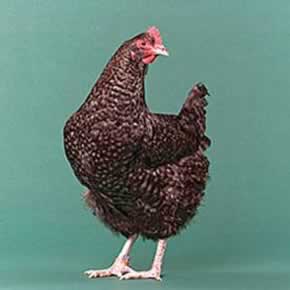
Size: Medium to large
Color: dark chocolate brown
Qty: Medium – 3 / wk
Temperment
Well adaptable to confinement or free range
Varies widely: very active; calm or wild, difficult or easy to manage
Brooding: some strains very broody after 1st yr
Hardiness: some strains less hardy
Maturing: very slow to mature
Physical
Varieties: Dark, Cuckoo, others
Weight:
- Standard: 7 lb (3.2 kg)
- Bantam: 2.2 lb (1.0 kg)
Comb: single
Legs: white skin and shanks
Ears: red
Class
APA: not recognized (2008)
PC: Soft Feather Heavy
Type
Layer
Feather or Clean Footed,depending on country standard or strain
Rarity
Once little known, but now becoming trendy. 4%
Origins
Developed in France in early 20th century. Since French and English standards are different, and both have been imported into North America, standardization in the US may not occur any time soon.
Notes
Known for one thing -- chocolate colored eggs. James Bond’s favorite eggs.
Krauth Farms History
(none)
Links
Club: www.maransofamericaclub.com/index.html
Club: www.maransusa.org
FeatherSite: www.feathersite.com/Poultry/CGK/Marans/BRKMarans.html
Omlet UK: www.omlet.co.uk/images/maran_f_600.gif
PoultryPages: www.poultrypages.com/marans.html
ChickenBox: www.kippengrabbelton.be/engels/
RupertTheFish:
www.rupert-fish.co.uk/interests/poultry_breeding/maran_chickens.html
<top>
Silkie
Eggs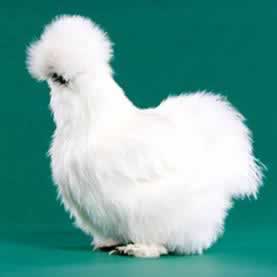
Size: Small
Color: light tint
Qty: Low – 1 / wk
Temperment
Adapts well to confinement
docile, friendly
Brooding: one of the most broody
Hardiness: hardy in heat & cold.
Because of fancy feathering, not suited for foul weather
Maturing: slow to mature
Physical
Varieties: Bearded & Beardless; Black, White, Blue, Buff, Partridge, Gray
Weight:
- True bantam: 2.2 lb (1 kg)
Comb: walnut
Legs: black skin & shanks
Ears: turquoise
Class
APA: (1874)
- Bantam: Rose Comb Clean Legged
PC: Soft feathered; Light & Bantam both
Type
Show
Black skin, face, comb, & wattles
Hair-like plumage
Turquoise earlobes
Five-Toed
Crested
Feather footed
Rarity
Probably the most popular bantam breeds. 100%
Origins
Already developed in China by the time of Marco Polo (13th century).
Large & Bantam classes are recognized in some countries.
Notes
An oddity of oddities of the poultry and pet world.
Links
Club: www.americansilkiebantamclub.org/
Links: www.geocities.com/Petsburgh/Park/3826/index.html
FeatherSite: www.feathersite.com/Poultry/CGP/Silkies/BRKSilkies.html
Okla State: www.ansi.okstate.edu/poultry/chickens/silkiebantam/
Omlet UK: www.omlet.co.uk/images/silkie_gold_f_600.gif
ChickenBox: www.kippengrabbelton.be/engels/
Other Chickens Not Listed Above
Breed |
Varieties / Rarity / What's a hen weigh? |
Class and Type |
Origins |
Egg productivity |
Comb |
Brooding |
Behavior |
<top> |
Black mottled, only Rather rare & in decline. Standard: |
APA (1898): Layer |
Developed in Italy in mid-19th century probably from leghorns sporting mottled feathers. Once rivaled the Leghorn in Europe, but never caught on in North America. |
|
single, also rose yellow skin & shanks white |
non-setter generally hardy; early maturing hens |
economical eater, prefers free range; nervous & restless in confinement; flyer; active, flighty, marked wildness, avoids human contact |
<top> |
Spitzhauben (Pointed Hood) & Barthuhner (Bearded) Spitzhauben available but Barthuhner practically unknown 4 lb/1.8 kg |
APA: Not recognized Layer |
Developed in Switzerland centuries ago. The name is thought to derive from the lace bonnets of the Appenzeller region. |
|
horn, V-shaped, duplex white skin, blueish white |
can be broody very cold hardy, early maturing |
not very tolerant of close confinement; flyer; active, flighty |
<top> |
Black, White, Black Breasted Red, Blue, Buff, Silver Purebreds are very rare. Standard: |
APA (1976): Layer |
Introduced from Chile in 1921, from one of several different blue egg-laying chicken "breeds," none called Araucana there. Likely that some "mongrelization" occurred before standardization. Truest bred carry a "lethal gene" which is also connected to the tufting characteristic. Standards differ from country to country. |
blue only small |
pea yellow skin, willow shanks red |
good brooder cold hardy moderately early maturing |
well adaptable to confinement or free range; calm, non-aggressive |
<top> |
Black, White, Duckwing, Red Spangled, Pyle, others Very rare. Standard: |
APA: Game |
Developed in India more than 2000 years ago, perhaps even 3500 years ago. Thought to be the breed from which the Cornish was primarily developed. |
lightly tinted small |
small pea yellow skin & shanks red |
can be broody, protective mothers robust; cold hardy; slow to mature |
bears confinement better than most other game breeds; extremely fierce & pugnacious, but docile & easily handled when away from other cocks |
|
<top> |
Black, only (standard); also blue & white Common Standard: |
APA (1929): Dual Purpose |
Developed in 20th century in Australia, primarily from the Orpington. Gained notoriety when one hen in the 1920s laid a record 364 eggs in 365 days. That performance has never been matched by subsequent Australorps. |
brown medium |
medium single white skin, dark shanks red |
good brooder; good mother very hardy; very cold hardy early maturing |
Well adaptable to confinement or free range; quiet, docile, easily handled |
|
<top> |
Double-laced, Blue-laced, White, Black, others Little known until recently. Standard: |
APA (2001): Dual Purpose |
Developed in late 19th century and early 20th century in Holland for dark egg laying. Developed from an older local variety that may date as early as the 12th century. In recent history, some strains have been bred for show and others for the darkness of their eggs. |
very dark reddish brown, with matte finish large |
single yellow skin & red |
can be non-setter or good brooder less cold hardy; slow to mature, & some chicks can be easily bullied |
well adaptable to confinement or free range; calm, friendly |
|
<top> |
14 recognized, including Quail, Porcelain, Black, Blue, Buff, Cuckoo, Mille Fleur, White, Mottled Uncommon True bantam: |
APA (1949): Bantam |
Developed in Anver region of Belgium many decades ago. Rumpless versions are called De Grubbe. Breed is often referred to simply as the Quail bantam, after the most popular variety. |
creamy white tiny |
rose white skin, dark shanks white |
good brooder robust chicks difficult to rear |
active, flyer; hens friendly, cocks can be aggressive |
|
<top> |
Mille Fleur, Porcelain, Black, Buff, White, Blue Mottled, Splash, Golden Neck, others One of the most popular bantams True bantam: |
APA (1914): Bantam |
First bred in Uccle (Belgium) before 1900 by Michel Van Gelder. Breed is often referred to simply as Mille Fleur, the most popular variety. |
creamy white tiny |
small single with large spikes white skin & shanks white |
great brooder hardy; because of fancy feathering, not suited for foul weather very slow to mature for full coloring |
tolerates confinement; fliers; quiet, friendly, cocks less aggressive than other banties |
|
<top> |
Black, Blue, Buff, Mille Fleur, Porcelain, White, Mottled, others Very rare True bantam: |
APA: Bantam |
One of the more ancient bantams; developed in the Netherlands. |
creamy white tiny |
single white skin & shanks bright red |
great brooder hardy some reports indicate chicks difficult to rear |
tolerates confinement; fliers; friendly, cocks can be aggressive |
|
<top> |
Light, Dark, Buff Less common. Standard: |
APA (1874):
|
Introduced from China in mid-19th century. The largest breed at the time. Before the name Brahma was settled on, they were also called Chittagongs, Shanghais (as were the Cochins), and Brahmapootras. |
brown medium |
pea yellow skin & shanks red |
good brooder robust; very hardy in heat & cold slow to mature |
adaptable to confinement or free range; mostly gentle; can be easied handled, but also standoffish; has a tendency toward fatness |
|
<top> |
Nut brown only Very rare. 6.5 lb/2.9 kg |
APA (1904): Dual Purpose |
Developed by Mrs. Nettie Metcalf of Warren, Ohio, in late 19th century. Never widely popular. |
brown medium |
pea white skin & blue/gray shanks red |
can be broody very cold hardy moderately slow maturing |
adaptable to confinement, very adaptable to free range; calm, friendly |
|
<top> |
Golden, only Rare, even as a show bird 5 lb/2.3 kg |
APA (1918): Layer |
Developed in Sicily, in mid-19th century. |
white small |
buttercup yellow skin & shanks white |
non-setter heat tolerant; combs subject to frostbite early maturing, but full comb takes longer |
does not do well in close confinement; very fidgety; active, flighty, wild even for a Mediterrean breed; avoids human contact |
|
<top> |
Golden, Silver Uncommon. 5 lb/2.2 kg |
APA (1914): Layer |
May have ancient ancestry, but refined & further developed in Belgium in the 19th century. Braekel is a closely related European breed. |
white medium |
large single white skin, blue shanks white |
non-setter hardy; comb subject to frostbite quick feathering but late maturing |
economical eater; adaptable to confinement, but prefers free range; flyer; alert, lively; inquisitive; some are rather wild, others can be friendly |
|
<top> |
Buff Very rare. 6 lb/2.7 kg |
APA (1949): Layer |
Developed in Spain in late 19th century as a meat & egg bird. |
white to light tint medium |
single yellow skin & shanks white |
non-setter very hardy in heat early maturing |
less tolerant of close confinement; active, vigorous, avoids human contact |
|
<top> |
White, Partridge Extremely rare. Rare even in Canada. 6.5 lb/2.9 kg |
APA (1921): Dual Purpose |
Developed in Canada in early 20th century by Brother Wilfred as a good meat & egg bird that could stand the extreme cold. |
brown large |
cushion yellow skin & shanks red |
can be broody extremely cold hardy early maturing |
bears confinement well; skittish, avoids human contact |
|
<top> |
Buff, White, Black, & Partridge Still popular as a show bird. Standard: |
APA (1874): Fancy: |
Introduced from China in early 19th century. Originally known as the Shanghai (a name also used for the Brahma). The breed that launched interest in poultry shows. Pekins are recognized as a separate bantam breed in some countries, rather than as bantam Cochins. |
tinted or yellowy brown small |
small single yellow skin & shanks red |
excellent brooder; good mother; excellent foster mother robust, cold hardy slow to mature |
well adaptable to confinement or free range; peaceful, friendly, easily handled |
|
<top> |
White, Dark, White Laced, Red, Buff Uncommon, Standard: |
APA (1893): Meat |
Developed in Cornwall in 19th century. Now principally used commercially for cross breeding purposes for Cornish X Rock. |
light brown small |
pea yellow skin & shanks red |
can be broody; protective mother cold hardy moderately early maturing |
poor forager; easily contained; less active; very docile for a game bird, noisy, can be friendly or aggressive |
|
<top> |
Black Very rare. 6.5 lb/3 kg |
APA (1874): Fancy: |
Developed in Normandy, perhaps before the 18th century. |
white medium |
horn, V-shaped, duplex white skin, dark shanks red [hidden by feathers] |
non-setter because of fancy feathering, not suited for foul weather; may have problems with freezing crest feathers |
suited for close (and dry) confinement; active; not particularly friendly |
|
<top> |
Black-Breasted Red, White, Black Practically unknown outside the Caribbean until recently. 4.5 lb/2 kg |
APA (1939): Game |
Developed in Cuba in 19th century from Phillipine or Indonesian stock. |
white small |
pea white skin & shanks white |
great brooder very hardy in heat slow to mature |
excellent forager; needs to be active; less tolerant of close confinement; aggressive, noisy |
|
<top> |
White [Columbian] Rare. 6.5 lb/2.9 kg |
APA (1952): Dual Purpose |
Developed by George Ellis in 1940 in Delaware. |
medium to rich brown good winter layer large |
single yellow skin & shanks red |
can be broody robust; hardy in heat & cold early maturing |
well adaptable to confinement or free range; calm, friendly |
|
<top> |
Barred only Rare, but now has new interest. 5 lb/2.2 kg |
APA (1874): feathers prized for fly tying |
Developed in New England in early 19th century. Not distinguished from the Barred Rock until APA Standards were developed. Most modern Dominques may be traced to stock developed by A. Q. Carter after 1900. |
brown good winter layer medium |
rose yellow skin & shanks red |
good brooder; good mother robust; cold hardy early maturing |
well adaptable to confinement or free range; calm mostly, but more flighty than other dual purpose breeds |
|
<top> |
Silver Gray, White, Colored Extremely rare. Standard: |
APA (1874): Dual Purpose |
Ancient; believed to have been introduced to England by Romans -- based primarily on a description by a Roman writer of a chicken with five toes. |
creamy white to light tint medium |
rose & single white skin & shanks red |
great brooder; good mother less hardy in general, but cold hardy chicks delicate & slow to mature |
adaptable to confinement or free range; does not scratch excessively; calm; stately or awkward; fattens easily; gentle; friendly; easily tamed & handled |
|
<top> |
11 recognized, including Light Brown, White, Black, Blue, Blue Light Brown, Silver Rare. True bantam: |
APA (1992): Bantam |
Developed in the Netherlands, perhaps from Dutch East Indies stock. Introduced to North America after WWII, declined, reintroduced in the 70s & 80s. |
light tint tiny |
single white skin & white or blue shanks white |
broody; protective mother hardy slow to mature |
tolerates confinement; fliers; active, lively, cocks have been compared to snapping turtles |
|
<top> |
Gold & silver penciled Still rare. 3.5 lb/1.6 kg |
APA: Not recognized Layer |
Ancient Egyptian origins; only recently spread to the rest of the world. |
off-white to light tint small |
single white skin, dark shanks white |
non-setter very hardy; excellent hot weather bird quick feathering & very early maturing |
very economical eater; does not like containment; lively; flighty, known for wildness |
|
<top> |
Silver-Spangled, Golden-Spangled, Golden-Penciled, Silver-Penciled, White, Black Less common. Standard: |
APA (1874): Layer |
Developed in Holland (not Germany) before 1700; may be ancient. Historical names include Pheasants, Moonies, Crescents, Corals & Everlayers |
low-gloss white small |
rose white skin, slate blue shanks white |
non-setter/p> hardy; cold hardy very early maturing |
very economical eater; likes wide range; less tolerant of close confinement; high flyer; very flighty; spritely, active, avoids human contact |
|
(No picture available) <top> |
White & Barred Rare. 6.5 lb/2.9 kg |
APA (1949): Dual Purpose |
Established in 1949 as an improved, yellow skinned, heavy breed with white eggs. Unknown in Holland & most of the rest of world. |
white medium |
single yellow skin & shanks red |
can be broody cold hardy moderately slow maturing |
well adaptable to confinement or free range; calm, good tempered |
|
<top> |
White, Mottled Uncommon. Standard: |
APA (1874): Dual Purpose |
Developed in France before 1700, possibly as a cross between Polish and Dorking or related breeds. |
white small to medium |
leaf (or V) white skin, darker shanks red [hidden by feathers] |
can be broody because of fancy feathering, not suited for foul weather; may have problems with freezing crest feathers early maturing |
economical eater; bears confinement well; active; docile; easily handled |
|
<top> |
Black, White, Black Tailed, Birchen, Mottled, others Popular True bantam: |
APA (1874): Bantam |
Developed in Japan as early as the 7th century perhaps from Indo-Chinese stock. First introduced to Europe in 1860. Truest bred carry a "lethal gene" which is also connected to the shortened leg characteristic. |
creamy white tiny |
large single white skin & shanks bright red |
excellent brooder; protective mother because of short legs & fancy feathering, not suited for foul weather slow to mature |
tolerates confinement; some are fliers; generally friendly, cocks can be aggressive |
<top> |
Black, Mottled Extremely, perhaps critically rare. 7.5 lb/3.4 kg |
APA (1874): Dual Purpose |
Developed in U.S. after being introduced from Java in 1835. |
brown medium |
single yellow skin, dark shanks red |
good brooder cold hardy very slow maturing |
well adaptable to confinement or free range; calm |
<top> |
Black, Blue, White, & Cuckoo Very rare. 5.5 lb/2.5 kg |
APA (1874): Dual Purpose |
Dates back to France before 1660. |
tinted white large |
horn, V-shaped, duplex white skin, dark shanks white |
non-setter hardy early maturing |
well adaptable to confinement or free range; active, flighty, avoids human contact |
<top> |
Black/white/black pattern. Rare. 4 lb/1.8 kg |
APA (1939): Layer |
Developed in Germany in early 19th century. Golden Lakenvelders are not standard. Vorwerk is a bantam with the black/gold/black pattern. |
white to light tint small |
single white skin, dark shanks white |
non-setter hardy early maturing |
well adaptable to confinement or free range; flyer; flighty, avoids human contact |
<top> |
White Extinct or verging on extinction. 6.5 lb/2.9 kg |
APA (1933): Dual Purpose |
Developed by Harry Lamon in 1912 specifically to be a yellow skinned heavy breed with white eggs. |
white medium |
single yellow skin & shanks red |
|
|
<top> |
Black, White, & Blue. Uncommon. 7.5 lb/3.4 kg |
APA (1883): Dual Purpose [formerly Meat] |
Introduced from China in mid-19th century. Major Croad introduced them to England & gave his name to an early variety of Langshans. In Europe & elsewhere, distinctions are made between Croad & Modern Langshans. |
brown medium |
single greyish white skin, dark shanks red |
can be broody very hardy; cold hardy slow to mature |
well adaptable to confinement or free range; active for their size; graceful; not as calm or docile as other large breeds |
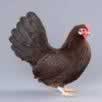 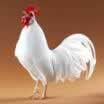 Leghorn The ultimate egg machine. <top> |
Dark Brown, Light Brown, White, Buff, Black, Silver, Red, Black-Tailed Red, Columbian Common Standard: |
APA (1874): feathers prized for fly tying |
Ancient, but greatly developed in 19th & 20th centuries. Honored by the Romans, and the white variety was reportedly developed for use in ceremony and foretelling the future. One of the most popular birds around the globe. |
pearl white (non-white feathered varieties are less prolific.) medium to large [commercial whites are especially large] |
large single; also rose yellow skin & shanks white |
non-setter hardy; heat tolerant (esc. white variety); combs subject to frostbite very early maturing |
economical eater; well adaptable to confinement or free range; flyer; flighty; spritely, noisy, nervous, usually avoids human contact |
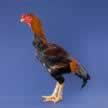 Malay FS OK PP GO PB A cruel looking giant on long legs. <top> |
Black Breasted Red, only Very rare 7 lb/3.2 kg |
APA (1883): Game |
An ancient breed, introduced from Malay |
light tint or brown medium |
strawberry yellow skin & shanks rich red |
can be broody hardy, very hardy in heat very slow to mature |
needs to be active; less tolerant of close confinement; more placid than most game birds |
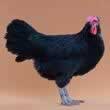 Minorca Largest Mediterranean, extra large eggs. <top> |
Black, White, Buff Rare to uncommon. Standard: |
APA (1888): feathers prized for fly tying |
Developed in Spain (and Minorca?) Once known as the Red-faced Black Spanish. |
white large |
single & rose white skin, dark shanks white |
non-setter excellent hot weather bird; combs subject to frostbite early maturing |
adaptable to confinement, but prefers free range; restlessly active, flighty, avoids human contact |
<top> |
Black-Breasted Red, Silver Duckwing, Red Pyle, White, Black, many others Uncommon Standard: |
APA (1874): feathers prized for fly tying |
Developed in England in 19th century for exhibibiton, not for cockfighting. |
white to light tint small |
large single (often dubbed) yellow skin & shanks red |
can be broody; protective mother hardy in heat & cold; some subject to health problems slow to mature |
needs to be active; less tolerant of close confinement; aggressive, noisy |
<top> |
Black, White, Red, other Uncommon. Standard: |
APA (1965): Fancy: |
Developed near Transylvania in early 18th century. |
creamy light brown medium |
single yellow skin & shanks red |
can be broody; good mother hardy in cold; does well in high heat because of fewer feathers, but can get sunburned slow to mature |
well adaptable to confinement or free range; active; mild mannered; friendly; easily handled |
<top> |
Light brownish red, only Fairly common Standard: |
APA (1935): feathers prized for fly tying |
Developed in New Hamphire from the Rhode Island Red in early 20th century. |
light to medium dark brown good winter layer large |
large single yellow skin & shanks red |
good brooder & mother robust; hardy in heat & cold; combs subject to frostbite very early maturing |
well adaptable to confinement or free range; calm, can be friendly or aggressive |
<top> |
Black-Breasted Red, Silver Duckwing, Red Pyle, White, Black, many others Uncommon Standard: |
APA (1928): feathers prized for fly tying |
Developed in England in 19th & 20th century from ancient stock |
white to light tint small |
large single (often dubbed) white skin & shanks red |
excellent brooder; protective mother hardy; cold hardy slow to mature |
needs to be active; less tolerant of close confinement; aggressive, self-sufficient; noisy |
<top> |
Red, White Very rare 6.0 lb/2.7 kg |
APA: Not recognized (dropped from Continental) Fancy: |
Reportedly developed in Russia in 18th century from Persian stock. Once called Chlianskaia, current name probably derives from Count Orloff-Techesmensky, a Russian breeder |
light brown small |
walnut yellow skin & legs red |
non-setter hardy slow to mature |
adapts to confinement; calm, but not docile, avoids human contact |
<top> |
Buff, Black, Blue, White Only buffs are still popular. Standard: |
APA (1902): Dual Purpose [formerly Meat] |
Originally developed by William Cook in Orpington (County Kent) the 1880s. Some varieties developed by his daughter. |
brown good winter layer medium to large |
single white skin & white or dark shanks red |
good brooder; excellent mother hardy; very cold hardy moderately early maturing |
adaptable to free range; very adaptable to confinement; docile; affectionate, easily handled; can be bullied |
<top> |
Creole, Partridge, Wheaten, Black Very, very rare. Only recently available in North America. 4 lb/1.8 kg |
APA: Not recognized Layer |
Rescued, or somewhat developed, from ancient stock in Catalan district of Spain in 20th century. Penedesenca Negra developed in 1980s. |
very dark red-brown small to medium |
clavell (carnation) white skin; blue-grey shanks white |
non-setter very hardy in heat slow to mature |
well adaptable to free range; active; flighty; avoids human contact |
<top> |
Partridge; Silver Duckwing; White; other colors Uncommon 36% Standard: |
APA (1965): hackel feathers prized for fly tying |
Developed in Europe and the U.S. from the Japanese long-tailed breed called the Onagadori. |
white to tinted small |
single yellow skin; yellow or slate shanks red |
can be broody, protective mothers reportedly short lived; because of fancy feathering, not suited for foul weather slow to mature |
requires special housing or cages & high perches to accommodate long tails; generally docile; not friendly |
<top> |
Barred, White, Buff, Silver Penciled, Partridge, Columbian, Blue Popular Standard: |
APA (1874): feathers prized for fly tying |
Developed in New England in 19th century. Once common on the homestead, still popular in the backyard. |
light (or pinkish) to medium brown good winter layer large |
small single yellow skin & shanks red |
broods, but infrequently; good mother robust; very cold hardy somewhat early maturing |
well adaptable to confinement or free range; docile, friendly, easily handled |
<top> |
Bearded & Beardless; Black, White, Golden, Silver, Buff Laced Popular as a show bird. 4-4.5 lb/1.8-2 kg |
APA (1874): Fancy: |
Originated in Europe, but probably not Poland, before the 16th century. Once known for good egg production, now almost strictly ornamental. |
(varies widely) white small |
small V white skin, blue shanks white |
non-setter some subject to health problems; because of fancy feathering, not suited for foul weather; may have problems with freezing crest feathers; special care may be needed since plumage blocks vision |
poor forager; bears confinement well; friendly, quiet; can be bullied |
<top> |
Red & black pattern, only Very rare. 6 lb/2.7 kg |
APA (1888): Layer |
Developed in Derbyshire. |
white small |
very large spiked rose white skin, blue shanks red |
non-setter hardy moderately early maturing |
can adapt to confinement; active |
<top> |
Rhode Island Red & Rhode Island White (two separate breeds) Popular, but purebreds are uncommon. Standard: |
APA (1904/1922): Large: American Dual Purpose |
Developed in New England in 19th century. |
rich medium brown good winter layer large |
large single; also rose yellow skin & shanks red |
broods infrequently; can be dutiful mother robust; hardy in heat & cold; combs subject to frostbite moderately early maturing |
well adaptable to confinement or free range; active, calm & fairly docile, can be aggressive (cocks are especially notorious) |
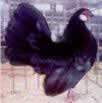 Rosecomb FS AR Om PP The original rosecombed, clean-legged bantam <top> |
Black, White, Silver Laced, others. Common. True bantam: |
APA (1874): Bantam |
Origins unclear & disputed. Claimed to be direct descendant of the original Bantam, but may be related to Hamburg. |
white to cream tiny |
rose yellow skin & shanks white |
not broody hardy in heat & cold slow to mature? |
tolerates confinement; fliers; generally friendly, cocks can be aggressive |
<top> |
Silver, Golden Very popular. True bantam: |
APA (1874): Bantam |
Developed before 1810 in England by Sir John Sebright, after thirty years of breeding. |
creamy white tiny |
rose yellow skin & shanks purplish red |
not broody not robust; chicks difficult to rear slow to mature |
tolerates confinement; fliers; jaunty, sprightly |
<top> |
White-Faced Black only Very rare, & becoming even rarer. 6 lb/2.7 kg |
APA (1874): Layer |
Oldest of the Mediterranean breeds, developed in Spain. |
white large |
large single grey skin, dark shanks white |
non-setter reportedly subject to health problems; heat tolerant; combs subject to frostbite slow to develop; white face takes more than a year |
adaptable to confinement, but prefers free range; flighty, haughty, noisy, avoids human contact |
<top> |
White, only Uncommon. 4.0 lb/ 1.8 kg |
APA (1874): Fancy: |
Introduced from Turkey in mid-19th century. |
white small |
horn, V-shaped, duplex white skin & shanks white? [hidden under feathers |
non-setter not suited for foul weather; may have problems with freezing crest feathers moderately slow developing |
poor forager; suited for close confinement; calm, non-aggressive, easily handled |
<top> |
Black, only Uncommon 7 lb/ 3.2 kg |
APA (1883): Game |
An ancient breed, introduced from Sumatra. |
white medium |
large single yellow skin & shanks dark red |
can be broody hardy in heat & cold |
needs to be active; intolerant of close confinement; pugnacious |
<top> |
Speckled, Red, Light Uncommon. Standard: |
APA (1914): Dual Purpose |
Developed in county of Sussex in early 19th century. |
creamy to light brown good winter layer medium to large |
single white skin & shanks red |
good brooder & mother robust; very cold hardy moderately early maturing |
well adaptable to confinement or free range; calm; gentle; active; can be curious; friendly; easily handled |
<top> |
Red Partridge Once little known, but gaining popularity. Standard: |
APA (2001): Dual Purpose |
Developed in Holland in 20th century. |
rich dark terracotta brown large |
small single yellow skin & shanks red |
mixed reports on setting & brooding hardy; cold hardy moderately early maturing |
economical eater; well adaptable to confinement or free range; lively, but not especially flighty; energetic; friendly |
<top> |
Silver Laced, Golden Laced, White, Buff, Partridge, Silvered Penciled, Columbian Popular. Standard: |
APA (1883): feathers prized for fly tying Dual Purpose |
Developed in New York State & Wisconsin in late 19th century. |
light to rich brown good winter layer large |
rose yellow skin & shanks red |
broods, but infrequently; excellent mother robust; very cold hardy moderately early maturing |
well adaptable to confinement or free range; calm, industrious, usually docile, but can be aggressive; some are aloof, others friendly |
<top> |
Red shouldered & white; White; other colors Rare 4 lb/ 1.8 kg |
APA: hackle feathers prized for fly tying Fancy: |
Called Yokohama from the port of origin. Developed in Germany in the 19th century from the Japanese long-tailed breed called the Minohiki. |
tinted small |
walnut or pea yellow skin & shanks white |
can be broody; protective mothers because of fancy feathering, not suited for foul weather slow to mature |
requires special housing or cages & high perches to accommodate long tails; generally docile; cocks can be pugnacious around other cocks |



